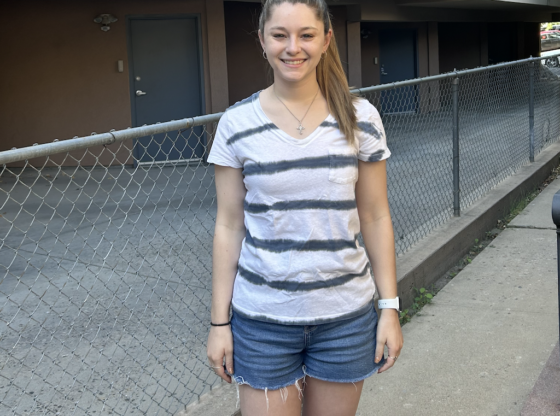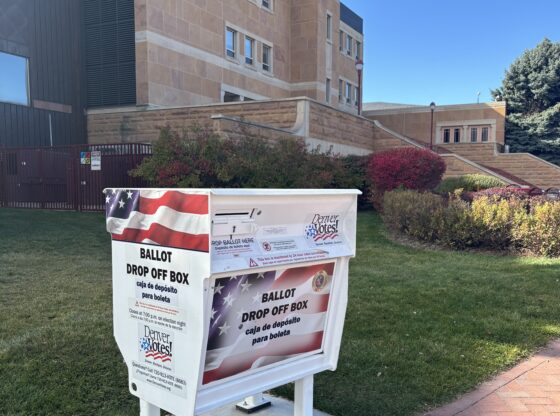As the lights dimmed, the fog began to creep in, rolling slowly up the corridor and eventually falling to rest in a delicate film that lingered on the stage. Soon, utter darkness and silence filled the theater, with the exception of the bells that began to toll, long, deep and ominous—dong, dong, dong— awakening an eerie sensation of imminent death in all who sat in the cold, dark theater, uncomfortably awaiting the unknown.
This psychoacoustic manipulation successfully controlled the audience’s emotions, bringing them into the moment and keeping their attention focused for the duration of the performance.
The DU Department of Theatre’s spring quarter mainstream production was the regional premiere of Naomi Wallace’s award-winning play “One Flea Spare.” The performance took place inside the Elizabeth Eriksen Byron Theater in the Newman Center for the Performing Arts. It ran at 8 p.m. on May 18, 19, 20, 26 and 27, and a 2 p.m. matinee was shown on May 27 and 28.
Making its debut in London in 1995 and premiering on Broadway in 1997, One Flea Spare offers an intimate and gruesome glimpse of life during the last Great Plague of London in 1665.
The plague had more or less subsided by the 1660s. This particular summer, however, was marked by abnormally hot weather that cruelly invited the return of the bubonic plague, which killed close to 100,000 people before the Great Fire of London in 1666 put an end to one of the world’s most disastrous epidemics to date.
The story is set inside a lavish house in Axe Yard, off King Street in Westminster that is owned by the wealthy elderly couple Mrs. Darcy and Mr. William Snelgrave. The Snelgraves, played by senior Kari Delany and junior Chris L. Johnson, were ordered to endure a 28-day quarantine inside their house after their servants died from the plague.
On the 25th day of their quarantine sentence, two unwanted guests broke into the home they thought was abandoned to seek shelter, food and loot. Unable to hide the presence of their new residents from the guard patrolling their home, the Snelgreves, along with their intruders, were forced to undergo a second 28-day quarantine sentence, secluded in the two tiny rooms of the house that hadn’t yet been touched with death.
Senior Lyndsay Dru Corbett played the part of Morse, the narrator of the story and a 12-year-old girl who claims to be the daughter of a wealthy aristocratic couple who has died. Her childish innocence is contrasted by her stark wisdom that far surpasses her years.
The second intruder, played by senior Adam Odekirk, is Bunce, an unruly sailor who is first discovered by the Snelgraves when he is urinating himself into one of Mrs. Snelgraves’ finest vases.
The fifth character, played by senior Colin Day, is Kabe, an obscene and perverted guard with a thick Cockney accent who is assigned to patrol the Snelgraves’ home to enforce their quarantine.
The story begins with the characters behaving according to their traditional gender and socioeconomic roles. The Snelgraves are dressed in traditional ornate garments, while Bunce wears ratty sailor’s rags and Morse is dressed in peasant’s dress, dirty from wandering the streets.
As time goes on, however, the lines begin to blur and power shifts between the four members of the house. A turning point occurs when William allows Bunce, who has taken on the role of the servant, to take a break from washing the floors to try on his fine gentlemen’s shoes and cane, the likes of which a poor sailor would never have the chance to wear under ordinary circumstances.
Though William abhors her childish games and nosiness, Darcy adores Morse and tells her she has the breath of an angel. Morse’s persistence to see Darcy’s uncovered neck and hands eventually reveals that she was badly burned in a fire when she was 17. Married for only two years at the time, William, disgusted with her scarred skin, never touched his wife again. Further dialogue reveals that William took sexual liberties with his servants and beat them to keep order in the house.
When Bunce learns that Darcy has gone unloved for all of these years, he expresses an interest in pleasing her, and his lust is reciprocated after she becomes aroused from hearing stories of his homosexual escapades at sea.
When William learns of Darcy’s affair with Bunce, he tries to take control of the situation, but the other three are able to overcome his power when they tie him to a chair using Bunce’s sailor’s rope. Bunce strips William of his fancy clothing, symbolically and physically taking on the role of the new man of the house.
“On some of the nights, the audience has clapped when William was tied up. It shows how strongly they hate this character,” said Johnson.
In the end, as tragedy transpires, it is Morse who steps up to face this despondency with tremendous courage and resilience.
Each of these characters are fleshed out with layers upon layers of previously suppressed emotions that are continually peeled away, each new scene revealing the anger, rage, sorrow, regret, pain, lust, love and despair that lie within them. The play demonstrates how tragedy and seclusion can bring out the worst, and consequently the best in people.
Director Kim Axline writes in her notes, “It is surely one of life’s most poignant ironies that from great suffering may come transcendant beauty; from catastrophic loss, a renewed hope for the future; from death and disease, life and vitality. In One Flea Spare, while none may claim to be ‘innocent,’ their crucible of confinement reveals a similar paradoxical infinity of beauty blossoming from corruption, and an eternity of life and death encompassed in two brief hours.”
Delany said, “The stakes are higher because they’re stuck in a life or death situation. There’s a quote by Maya Angelou that says ‘I am human, and nothing human can be alien to me.’ We’re all human, and we’re all capable of doing these things when people are pushed to certain limits. You can’t be a part of a play without it affecting you.”
The plague took the lives of thousands of people, but this play was focused on merely five of those who endured the impact of this devastating epidemic.
“Focusing on five people created a more emotional experience. As Kabe is announcing the dead, they’re just numbers. There’s no emotion involved when you just hear the numbers,” said Day.
“One Flea Spare” offers an in-depth glimpse of the affect this tragedy had on each and every person involved. Multiplied by the hundreds of thousands, one can begin to understand the depth of the despair that accompanied this tragic disease.
When asked if the melancholic theme of the play brought her down, Corbett said, “Theatre allows for a release, a purging of emotions. You have to compensate. We all joked around a lot backstage before and after our performances. Being in a play like this makes you want to feel more happy.”
Odekirk added that the five actors had all worked together before, so the group was very close knit.
“One Flea Spare” was free to the DU community, and drew an average audience size of 85-90 at night and about 20 during the matinee performances.











